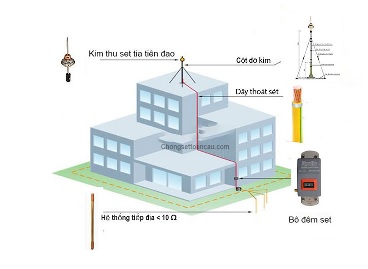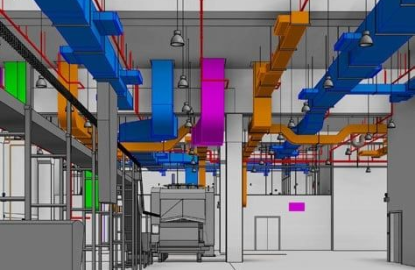FIRE ALARM SYSTEM
I. DEFINITION OF AUTOMATIC FIRE SYSTEMS
Fire alarm system is the system of collection of duties device detection and fire alarm occurs when. The discovery of fire signals may be performed automatically by the device or by the people, and not necessarily continuous operation in 24/24.
II. COMPONENTS OF A SYSTEM OF AUTOMATIC FIRE
An automatic fire alarm system will typically have three components as follows:
1. Fire Alarm Center
Designed as cabinets, cc main equipment includes: a motherboard, a transformer, a battery.
2. Input Devices
– Detectors: Smoke detectors, heat detectors, gas report, fire report.
– Emergency switch (emergency button).
3. Output Devices
– The secondary display (keyboard).
– Alarms, sirens.
– Lights up, lights EXIT.
– The automatic telephone dialing.
III. PRINCIPLE OF OPERATION OF FIRE SYSTEM
Operating procedures of fire alarm system is a closed process. When the phenomenon of combustion (such as a sudden increase in temperature, the presence of smoke or sparks) and input devices (detectors, emergency switch) receive and transmit signal information malfunction of the fire. At this center will process the information received, locate where the fire occurred (through the zone) and transmits the information to the output device (display side tables, bells, whistles, lights), This device will sound signal, light for people to get to know the area fire going and timely treatment.
IV. FIRE CLASSIFICATION SYSTEM
• Fire alarm system using two different types of voltage: 12V and 24V.
Theoretically there are both technical features and utilities alike. But, compared to the fire alarm system, the fire alarm system 24V 12V non-professional, 12V center mainly used in burglar alarm systems, in addition to the system is required to be programmed keypad. While 24V fire alarm system is a professional fire alarm systems, signaling the ability to go further, and are not required to be programmed keypad. However, the processing center fire alarm system 12V (Networx center) which is less than the processing center fire alarm system 24V (Mircom center, …)
In addition, the fire alarm system is divided into two main systems, including:
1.He conventional fire alarm:
With simple, low cost, conventional fire alarm system installed at appropriate only companies with medium or small area (a few thousand m2), the number of departments are not many (tens of room ) installation for home, small workshops … The equipment in the system are connected in series with each other and connected in series with the fire, so the center of the incident can only recognize and display overview entire urban area (zone) that monitor system (not to know the exact location of each detector, each location there is a fire). This limits the processing capability of supervisors
2.He addressable fire alarm:
With high-tech features, addressable fire alarm system for installation at the company premises using large (several tens of thousands of m2), is divided into several independent regions, departments within each separate areas together. Each device in the system is wired directly to the fire control center receives the signal helps fires in each area, each location explicitly and accurately. Since then the center can get information incident in detail and is shown on the display panel assisting staff can monitor troubleshooting quickly.
V. DETAILED EXPLANATION OF EQUIPMENT
1 – Fire Alarm Center: (from the Center, Control Center, Control Panel)
This is the most important devices in the system and determine the quality of the system. As power supply equipment for the fire alarm. Ability to receive and process signals from the fire alarm fire alarm signal or technical problems, display information about the system and issue the command alarm, indicating where fires occur. In case of necessity, may signal a warning to the destination. Having the ability to check the normal operation of the system, indicators of system problems such as broken wires, short circuit.
2 – Input device:
Equipment is sensitive to the phenomenon of combustion (heat increases, emissions, light and fire), and is responsible for the information where the fire occurred and transmit signals to the fire.
2.1 Detector:
2.1.1 Smoke detector: (Smoke Detector)
– A monitoring device directly detect signs of smoke to move the smoke signals the processing center. Time the smoke detectors receive and transmit information to the fire not too 30s. Environmental density from 15% to 20%. If the concentration of smoke in the environment in the region over the threshold (10% -20%), the device will signal the alarm center to handle.
– The smoke detector is usually located in the business center, conference hall, the vault, the area density of a confined space and often make incendiary smoke before.
– Smoke detector is divided into two main categories as follows:
2.1.1.1 as the smoke detector.
Be installed in areas that range monitoring small, low ceiling (office, apartment …)
a. Ionization Smoke Detector: The equipment creates positive ions and negative ions flow motion, the smoke, the smoke will impede the motion of positive ions and negative ions, from which the device will send alarm signals to the processing center.
b. Optical smoke detector (photo): The device consists of a pair of detectors (a first signal, a signal receiver) on each layout, alternating between the 2 when smoke detectors, smoke would impede traffic signal between the two detectors, which newspapers will send alarm signals to central processing.
2.1.1.2 Beam type smoke detector
– Includes a pair of devices installed at both ends of the monitored area. Device that shines a beam projector infrared, through the area under surveillance and to a receiving device containing a photosensitive cells is responsible for monitoring the balance of the signal beam. This detector operates on the principle of light blur opposite principles of light scattering (at the touch of smoke detectors).
– Beam type smoke detector with a wide dynamic range (15m x 100m), use appropriate in areas where the photoelectric type smoke detector proved to be inappropriate, such as in the first place where the smoke whether there will be black smoke.
– Further Beam type detectors can cope with extreme conditions of temperature, dust, excessive moisture, many impurities, … Do as Beam detectors can be placed behind glass in the window, so very easy to clean and preserve.
– Photoelectric Beam shape is usually installed in areas with large range surveillance, high ceiling mounted detectors can not point (the buildings, …)
2.1.2 Heat detector: (Heat Detector)
– Heat detector is used to detect the temperature of the environment within the scope of protection of the environment as the temperature does not satisfy the provisions of the heat detector specified by the manufacturer, it will signal send alarm processing center.
– The heat detectors are installed in the first place can not be installed smoke detectors (which contain equipment, Garage, electrodynamics chambers, factories, kitchens, …)
2.1.2.1 Fixed heat detector
A type of detector is activated and the alarm signal when the temperature sensor in the atmosphere surrounding the reported increase in the level of production rules (57o, 70o, 100o …).
2.1.2.2 Heat detector increases
A type of detector is activated and the alarm signaling induced phenomenon atmosphere surrounding the reported sudden temperature increase of about 9oC / min
2.1.3 The gas detector (Gas Detector)
– The direct monitoring equipment, detecting signs of gas when gas concentration ratio in excess of 0.503% (Propane / Butane) and send alarm signals to central processing.
– The gas detectors are usually arranged in roughly the room where numerous gas as gas or gas storage. The gas detector is mounted on the wall, the floor from 10-16cm, absolutely not permitted on the floor installed.
2.1.4 fire detector (Flame Detector)
– The sensors emit ultraviolet rays from the fire, received signal, and send alarm signals to the central processor to detect fire.
– Used mainly in places that are considered highly dangerous, where is the light of the fire signs typical for combustion (eg storage of flammable liquids).
– Flame detector is sensitive to ultraviolet light and have been meticulously researched to avoid false statement. Probe signal only alarm on the fire when 2 pulse UV induction after 2 period, each period is 5s.
2.2 emergency switch (breaker Emergency, emergency button)
Installed at conspicuous places of the stairs to the lobby to use when needed. This device enables users to proactively communicate with fire alarm by pressing or pulling the emergency switch, emergency alarm is present for people in that area are known to take measures for fire management and move out of the danger area by the emergency exits. Include the type of emergency rule as follows:
2.2.1 Emergency circle, square
2.2.2 Emergency glass (glass break)
2.2.3 Emergency shock
3 – Output Devices:
Receiving signals from the transmission to the central fire alarm and broadcast features sound information (bell, horn), with signal light (lamp) to help people recognize are the combustion takes place.
3.1 Sub-board
Show the information of the incident area from fire alarm communications center to help identify where the status of the incident to promptly handle.
3.2 Alarm
Installed in the guard room, the board room is staffed, hallways, stairs or through crowded places in order to inform those around you can see the problem is going to have a plan to deal reasonable, timely evacuation.
When a fire incident occurs, an alarm signal will alert guards to help identify and track equipment through fire incident (secondary display panel) will know what happened fire area fire, which promptly notify the employee is responsible for fire protection or troubleshooting appropriate treatment measures.
3.3 Fire Alarm Horn
Features and installation location as the fire alarm, horn however is used when the distance between the place where the message should receive alarm notifications so far.
3.4 Lights
Used for alarm signals, each type of lamp has different functions and is installed in the proper position to maximize the features of this device. Signage includes:
3.4.1 Indicator Exits (Exit Light)
Placed near the stairs of each floor, to indicate emergency exits in case of fire. Automatic lighting in case of AC power loss.
3.4.2 Fire Alarm Lamp (Lamp Corridor)
Placed on each floor of the emergency switch. Alarm light will light up when the switch emergency operations, and this is also the emergency lights to those present in the building is known. This is significant, because of the confusion caused by the fires, the user needs to clearly distinguish the valid public emergency is activated fire pumps.
3.4.3 Indicators room (Room Lamp)
Installed in front of each room that can help identify problems easily and quickly.
3.4.4 Lighting in case of emergency (Emergency Light):
When a fire alarm, the first step is to power outages. Now the lights are automatically turned on (thanks to battery backup battery), it makes it easier for people to find escape routes, or help for the staff responsible for the rapid implementation of the department. Or in the case of sudden power loss due to electrical problems, Emergency lights also proved effective.
3.5 The automatic telephone dialing
Mounted in the fire, after receiving information from the central fire alarm device will automatically dial the phone is pre-set to inform the person responsible. Normally shoot from 3 to more than 10 numbers.
3.6 Keyboard (keypad, keypad control):
As a means to control all operations of the system. Through the keyboard, you can control the desired operation easily, such as order entry system put into monitoring mode, or you can stop monitoring regime in some areas of the entire system, or can program the system to automatically switch to monitoring mode at a certain time of day for a certain region.
3.7 Module address:
Module addresses used in addressable fire alarm system, it has the ability to know the exact location where the fire incident in a protected region.
VI. STANDARD REQUIREMENTS AND DESIGN
Standard :
TCVN5738-1993: Fire alarm system requirements. This standard applies to the fire alarm system fitted at the factory, factories, manufacturing facilities, public agencies, etc.. – Fire alarm system is a system of devices that can automatically detect and notify fire location accuracy and ensure continuous system operation 24/24 hours.
2. Requirements design
* The design, installation, fire alarm systems must be agreed upon by the agency fire prevention, fire fighting and satisfy the requirements and regulations of standards and regulations related to current.
* Fire alarm system meets the following requirements:
– Detect fire quickly in the area of the incident.
– Transfer signal when detecting fire alarm to clear those around can immediately implement appropriate solutions.
– Having good anti-jamming capability.
– Not affected by the installation of common systems or other individual.
– Do not be paralyzed in whole or in part caused by the fire before the discovery of fire.
– Fire alarm system to ensure reliability. The system is fully implemented functions have been proposed without any flaws or other unfortunate circumstances.
– The impact caused the incident outside part of the system does not cause problems in the system next.
– The ability to provision high.
– The ability to easily expand the cost




